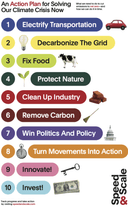blog →
Inflation Reduction Act's impact on over 300,000 clean energy manufacturing jobs
Steven’s note: this is a guest blog post from Rena Ramaraju, a student at Wellesley College working on The Big Green Machine- Tracking the North American Clean Energy Supply Chain project with Jay Turner, Professor of Environmental Studies at Wellesley College.
Also, be sure to check out ClimateTechList’s Inflation Reduction Act text viewer tool here
Introduction
The Inflation Reduction Act (IRA) of 2022 is a key component of President Biden’s agenda. It aims to increase domestic clean energy manufacturing by linking incentives like tax credits with requirements related to labor standards, domestic resource sourcing, and energy communities. Since its creation, the IRA has been driving large-scale investments and job creation in multiple sectors (batteries, electric vehicles, wind, solar) related to clean energy infrastructure.
Inflation Reduction Act impacts
Our database draws upon information from company press releases, articles, and other reports to assess the state of the clean energy supply chain and the impact of the IRA in North America. These resources detail the status of a project, along with other critical information like capital investment and projected job creation. Out of the 455 projects in our database, including projects started before and after the IRA, 176 sites are operating at either full or partial capacity, 68 sites are under construction, and 167 sites are planned. 182 of the 455 projects in our database have been announced after the IRA.
The clean energy sector is also drawing much foreign investment into the US clean energy supply chain. The largest investments are from South Korea, totaling $49.2 billion dollars, followed by Japan with $33.9 billion dollars.
The clean energy sector is also creating jobs. Including post and pre-IRA announcements, we are tracking 123,993 jobs in the battery sector, 217,579 jobs in the electric vehicle sector, 35,106 jobs in the solar sector, and 8,454 jobs in the wind sector—additionally, the roughly 128,000 jobs across all four sectors since the IRA became law in August 2022.
Almost all of the jobs pre- and post-IRA are in manufacturing. Jobs in extraction, materials processing, and recycling are small by comparison, and limited almost entirely to the battery sector.

Insights
Here are 3 insights from our data:
- The IRA has been creating jobs in areas where the median household income is below the national average. In the US 66 % of investments are going into communities with average median household incomes below $74,580.
- The IRA has also been creating jobs in areas where the unemployment rate is higher than the national average. In the US 70 % of investments are going into communities with an employment-population ratio lower than 60.1.
- In the battery sector, 73 % of investments are going into communities with higher unemployment.
As seen from the map below, these clean energy project sites are spread nationwide. But the areas seeing the greatest investment are in the emerging “Battery Belt” in the Southeast, led by states like Georgia and North Carolina.

Conclusion & learning more
Through our research we have compiled a database that looks at these manufacturing sites and how they contribute to the clean energy supply chain overall. We can see how the IRA has impacted information like job creation, capital investment, and site location. You can learn more about our work by visiting our website, https://www.the-big-green-machine.com/.
Steven’s note: be sure to check out ClimateTechList’s Inflation Reduction Act text viewer tool here
Join the ClimateTechList
Talent Collective →
GET NOTIFIED ABOUT
New high-impact climate tech companies & jobs
No spam. Unsubscribe any time.
Featured Blog Posts
Join the ClimateTechList
Talent Collective →
GET NOTIFIED ABOUT
New high-impact climate tech companies & jobs
No spam. Unsubscribe any time.
Featured Blog Posts






